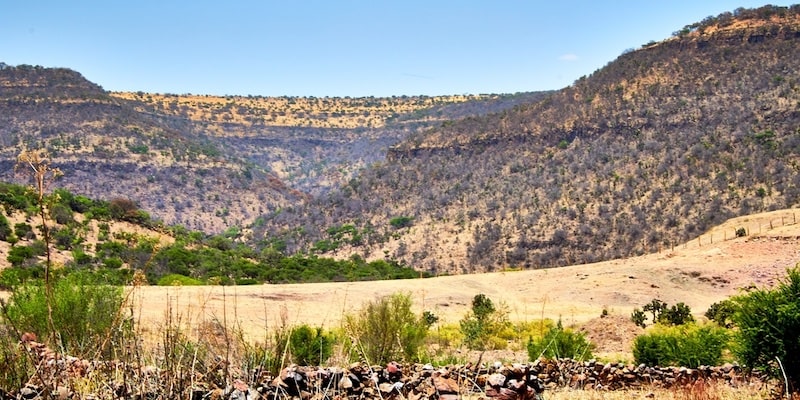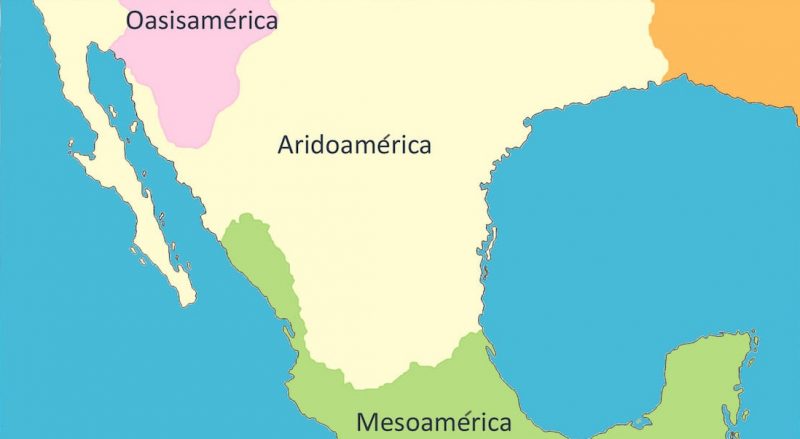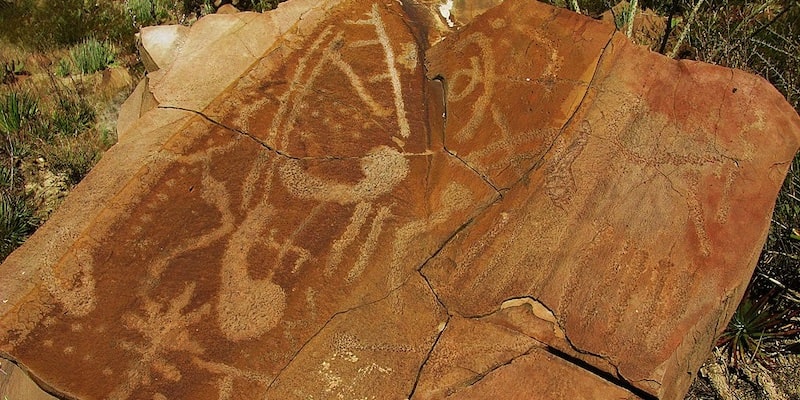We explain what Aridoamérica is, what territories it covers and what its characteristics are. Also, the various cultures that inhabited it.

What is Aridoamerica?
Aridamerica It is a cultural region of Central America which covers part of northern Mexico and part of the southwestern United States. It is one of the three cultural regions that anthropology identifies to study the ancient peoples who inhabited the current territory of Mexico. The other two regions are Oasisamerica and Mesoamerica.
Aridamerica It is characterized by having a dry and arid climate which means that its ecosystem has little vegetation and fauna. It has a varied topography that includes deserts, plateaus, canyons and plains. Among its most notable geographic areas are the Sonoran Desert, the Chihuahuan Desert, and the Great Plains.
The societies that inhabited Arid America before Spanish colonization were heterogeneous and remained isolated from each other. For this reason, they are not considered as a cultural unit as a whole. About thirty pre-Columbian Arido-American populations were identified and most of them were nomads. Their economy was based mainly on hunting and gathering.
See also: Mesoamerican cultures
Location of Aridoamerica

Aridamerica comprises the region of plains that extends between the western and eastern mountain ranges of the Sierra Madre.
Currently, this territory is located in the north of Mexico, in the states of Tamaulipas, Nuevo León, Coahuila, Baja California, Baja California Sur and part of San Luis Potosí, Zacatecas, Durango, Chihuahua, Sonora, Hidalgo, Guanajuato, Querétaro, Jalisco, Sinaloa and Aguascalientes. It also covers part of the southern United States, the states of California, Nevada, Utah, New Mexico, Arizona and Texas.
Characteristics of Aridoamerica
Arid America is characterized by having a desert ecosystem, with little fauna and vegetation. The populations that inhabited it mostly maintained a nomadic way of life with little contact with each other, so the region encompassed great cultural diversity.
Among the main characteristics of Aridoamérica are:
- desert ecosystem. It is a region of plains and wildlands that extends between the western and eastern mountain ranges of the Sierra Madre. It is characterized by having an extremely dry climate, very little rainfall, arid soils and great thermal amplitude.
- Nomadic and sedentary societies. Most of the people who inhabited Arid America had a subsistence economy based on hunting and gathering, so they maintained a nomadic way of life and lived in caves and natural shelters. Only some Arid-American societies practiced agriculture, built settlements, and led a sedentary life.
- Cultural diversity. The societies that inhabited Arid America had little contact with each other, so they remained quite isolated and did not form a common identity.
Arido-American cultures

The peoples who inhabited Arid America before the Spanish colonization of the region were of great cultural diversity. Specialists have identified more than thirty different cultural identities, most of which maintained little contact with each other.
Some scholars group the Arid-American peoples by their language or by the region they inhabited. Among these groups, we can identify:
- Acaxees. They inhabited the mountainous area of the Sierra Madre Occidental. They gathered in groups of extended families and practiced agriculture of corn, beans, pumpkins and other fruits.
- Chichimecas. They were a set of cultures (named after the Mesoamerican peoples) that inhabited part of the current Mexican states of Jalisco, Aguascalientes, Zacatecas, Guanajuato, San Luis Potosí and Querétaro. Among them were the Caxcanes, the Tecuexes, the Jonaces, the Guamares, the Guachichiles, the Pames and the Zacatecos. They were nomadic and semi-nomadic societies, and some practiced occasional cultivation.
- Monguis. They were a nomadic people who dedicated themselves to hunting and gathering on the Gulf coasts and the mountains of California. They were organized into warrior tribes that competed with each other for natural resources and control of certain spaces.
- Xiximes. They occupied the mountain region of the current Mexican state of Sinaloa. They were another of the sedentary Arid-American peoples who practiced agriculture and settled permanently. They built “cliff houses”, a type of housing that was made inside caves in the mountains.
- Yumanos. They were a group of diverse peoples (such as the Cucapá, the Yuma, the Mojave and the Halchidhoma) who inhabited the areas of Baja California and Arizona. These people created semi-permanent settlements and maintained commercial contacts with people from other areas of the arid-American region.
Economy of Arid America
The economy of Arid American societies was based on the exploitation of the scarce resources offered by the region's desert ecosystem. Most of these people dedicated themselves to hunting and gathering. Some cultivated corn and beans.
In Arid America, small mammals were hunted, such as rabbits, rodents, and deer. Also snakes, birds and different types of insects. In coastal areas, fishing was practiced. On the other hand, the different towns collected maguey, yucca, beans, chia, different types of cactus and honey.
Some of the Arido-American societies traded among themselves the products they obtained in the areas they inhabited. In addition, some traded with other societies belonging to the regions of Oasisamerica and Mesoamerica.
The cultural regions of ancient Mexico
In addition to Arid America, anthropologists identify two other cultural regions to study the societies that inhabited the current territory of Mexico before the arrival of the Spanish: Oasisamérica and Mesoamerica.
Oasisamerica
It is a region that is surrounded by the deserts of Arid America, in the southwest of the United States and the northwest of Mexico. It is a territory dominated by the Yaqui, Bravo and Colorado rivers. These three rivers feed a greater variety of flora and fauna, and allowed the people of the region to practice agriculture.
Mesoamerica
It is the region that covers south-central Mexico, Guatemala, Belize, El Salvador and the western areas of Honduras, Nicaragua and Costa Rica. It is a region of great natural and cultural diversity.
Dozens of civilizations lived there with different levels of political and social complexity. Among the most important were the Olmec, Teotihuacan, Mayan, Zapotec, Toltec, Mixtec and Aztec cultures.
References
- Galliano, A., Katz, M and others. (2015). The first civilizations. Social sciences. History and geographical spaces from the origin of man to the Middle Ages. Edelvives.
- López Austin, A and López Luján, L. (2001). The indigenous past. The College of Mexico.
- Boehm de Lameiras, B. (1991). The State in Mesoamerica. Study on its origin and evolution. Spanish Journal of American Anthropology21, pp. 11-51.





